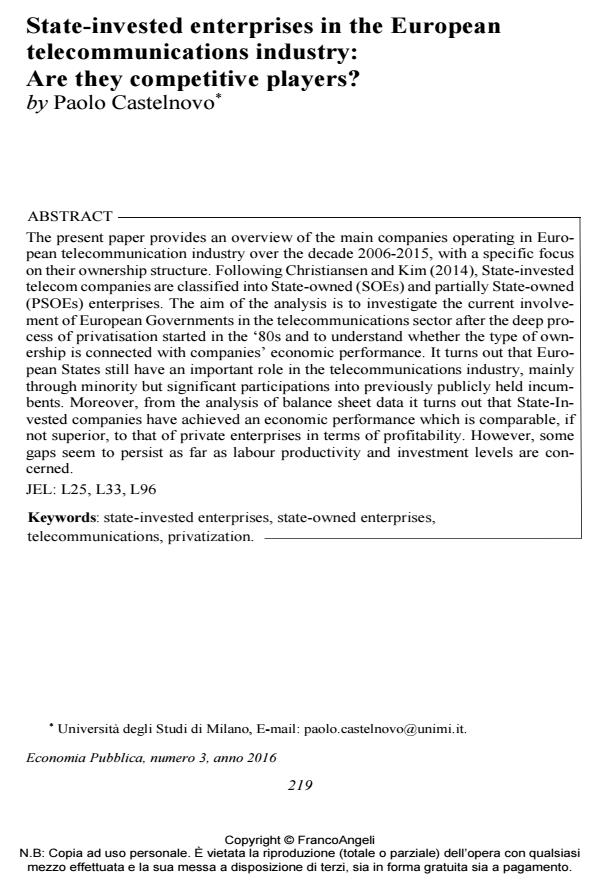State-invested enterprises in the European telecommunications industry: Are they competitive players?
Titolo Rivista ECONOMIA PUBBLICA
Autori/Curatori Paolo Castelnovo
Anno di pubblicazione 2017 Fascicolo 2016/3 Lingua Inglese
Numero pagine 22 P. 219-240 Dimensione file 251 KB
DOI 10.3280/EP2016-003008
Il DOI è il codice a barre della proprietà intellettuale: per saperne di più
clicca qui
Qui sotto puoi vedere in anteprima la prima pagina di questo articolo.
Se questo articolo ti interessa, lo puoi acquistare (e scaricare in formato pdf) seguendo le facili indicazioni per acquistare il download credit. Acquista Download Credits per scaricare questo Articolo in formato PDF

FrancoAngeli è membro della Publishers International Linking Association, Inc (PILA)associazione indipendente e non profit per facilitare (attraverso i servizi tecnologici implementati da CrossRef.org) l’accesso degli studiosi ai contenuti digitali nelle pubblicazioni professionali e scientifiche
The present paper provides an overview of the main companies operating in European telecommunication industry over the decade 2006-2015, with a specific focus on their ownership structure. Following Christiansen and Kim (2014), State-invested telecom companies are classified into State-owned (SOEs) and partially State-owned (PSOEs) enterprises. The aim of the analysis is to investigate the current involvement of European Governments in the telecommunications sector after the deep process of privatisation started in the ‘80s and to understand whether the type of ownership is connected with companies’ economic performance. It turns out that European States still have an important role in the telecommunications industry, mainly through minority but significant participations into previously publicly held incumbents. Moreover, from the analysis of balance sheet data it turns out that State-Invested companies have achieved an economic performance which is comparable, if not superior, to that of private enterprises in terms of profitability. However, some gaps seem to persist as far as labour productivity and investment levels are concerned.
Keywords:State-invested enterprises, state-owned enterprises, telecommunications, privatization
Jel codes:L25, L33, L96
- Alonso J., Clifton J., Diaz-Fuentes D., Fernandez-Gutierrez M. and Revuelta J. (2013). The race for international markets: were privatized telecommunications incumbents more successful than their public counterparts? International Review of Applied Economics, 27: 215-236. DOI 10.1080/02692171.2012.734791.
- Bauer J. (2003). The Coexistence of Regulation, State Ownership and Competition in Infrastructure Industries. Quello Center Working Paper N. 03-03, for Telecommunications Management and Law.
- Bennett J. and La Manna M. (2012). Mixed oligopoly, public firm behavior, and free private entry. Economics Letters, 117: 767-769.
- Christiansen H. and Kim Y. (2014). State-Invested Enterprises in the Global Marketplace: Implications for a Level Playing Field. OECD Corporate Governance Working Paper N. 14.
- De Fraja G. (1993). Productive efficiency in public and private firms. Journal of Public Economics, 50: 15-30. DOI: 10.1016/0047-2727(93)90058-2
- De Fraja G. and Valbonesi P. (2009). Mixed Oligopoly: Old and New. University of Leicester Working Paper N. 09/20.
- De Fraja G. and Delbono F. (1989). Alternative strategies of a public enterprise in oligopoly. Oxford Economic Papers, 41: 302-311.
- Edwards G. and Waverman L. (2006). The Effects of Public Ownership and Regulatory Independence on Regulatory Outcomes. Journal of Regulatory Economics, 29: 23-67.
- Florio M. (2013). Network Industries and Social Welfare, The Experiment that Reshuffled European Utilities. Oxford University Press.
- Florio M. (2014). Applied Welfare Economics. Cost-Benefit Analysis of projects and policies. Routledge. DOI: 10.4324/9781315817620
- Gasmi F., Maingard A., Noumba P. and Vito L. (2013). The Privatization of the Fixed-Line Telecommunications Operator in OECD, Latin America, Asia, and Africa: One Size Does Not Fit All. World Development, 45: 189-208.
- Kaufmann D., Kraay A. and Mastruzzi M. (2004). Governance Matters III: Governance Indicators for 1996, 1998, 2000, and 2002. World Bank Economic Review, 18: 253-287.
- Willner J. (2001). Ownership, efficiency, and political interference. European Journal of Political Economy, 17:
- Willner J. (2006). A Mixed Oligopoly Where Private Firms Survive Welfare Maximisation. Journal of Industry, Competition and Trade, 6: 235-251.
- Willner J. and Grönblom S. (2012). Reforming a Network Industry: Consequences for Cost Efficiency and Welfare. International Review of Applied Economics, 27: 265-284. DOI: 10.1080/02692171.2012.734789
- Rationales, performance and governance of public entreprises. Editorial introduction Luc Bernier, Massimo Florio, Johan Willner, in ECONOMIA PUBBLICA 3/2017 pp.5
DOI: 10.3280/EP2016-003001
Paolo Castelnovo, State-invested enterprises in the European telecommunications industry: Are they competitive players? in "ECONOMIA PUBBLICA " 3/2016, pp 219-240, DOI: 10.3280/EP2016-003008